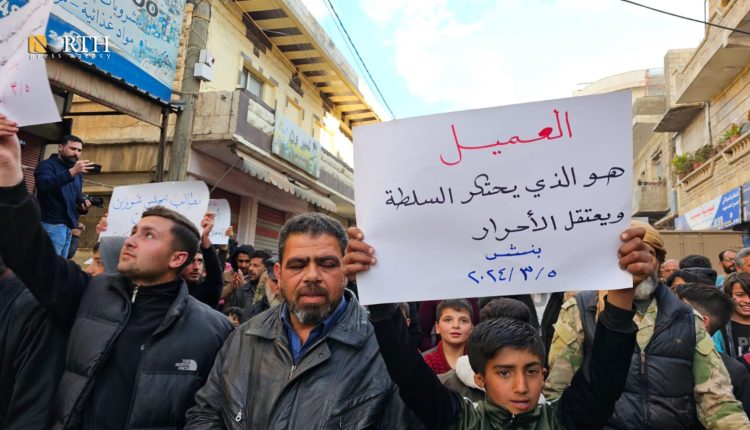
By Sarbast Hassan
QAMISHLI, Syria (North Press) – For several consecutive days, demonstrations fueled in northwest Syria against Hayat Tahrir al-Sham (HTS, formerly al-Nusra Front) and the group’s leader, Abu Mohammad al-Julani, observers view the situation as a precursor to a gradual disintegration, albeit over the long term.
Abdul Jabbar al-Oqaidi, a government forces’ defector and a military analyst, believes that these protests are a significant step toward dismantling the HTS, and can be considered the initial point toward that.
The HTS holds control over extensive areas in northwest Syria, including parts of Idlib Governorate and areas in the countryside of Latakia and Aleppo.
The protesters took to the streets for the first time on Feb. 27, and they gradually expanded the scope of the demonstrations until they reached the city center of Idlib in recent days.
They chanted slogans demanding the removal of al-Julani, the release of all detainees held within HTS prisons, and a comprehensive overhaul of the group’s policies.
However, a series of unexpected developments in recent months have posed a threat to al-Julani’s authority over the region. The first spark that ignited this threat was his decision to arrest top leaders of the group on charges related to collaborating with foreign entities and communicating with external parties.
Among these leaders was the prominent figure, Abu Maria al-Qahtani, along with other commanders.
The arrests did not last long due to pressures exerted on al-Julani, which prompted him to release the detainees and offer apologies.
HTS has no future
Al-Oqaidi told North Press that all armed groups like HTS and others have no political future and cannot govern for a long period. However, they are being utilized to serve specific agendas.
He stressed that the ultimate fate of any armed group is already known, same fate as the Islamic State (ISIS).
While these protests are not unprecedented, they stand out for their wider reach and heightened intensity compared to previous protests.
The military analyst believes that these events can be seen as a means of exerting pressure on the HTS, either regionally or internationally, and sending the HTS a message that the group can be eliminated internally without the need for any military conflict with other factions.
He further explained that in every Astana meeting, the topic of dismantling terrorist groups and their disintegration is consistently brought up.
“Both the government and Russia consider any force or group that opposes the government as a terrorist group and needs to be dismantled,” he concluded.
HTS serves Turkey, Russia
While Mahmoud Habib, official spokesperson of the Northern Democratic Brigade affiliated with the Syrian Democratic Forces (SDF) believes that the recent protests are a clear evidence of the people’s rejection of the policy of violence and terrorism followed by the HTS and al-Julani.
He further explained that like previous protests, the recent ones will be met with iron-fisted responses, including more repression, arrests, and brutal crackdowns.
In contrast, Turkey cannot abandon HTS under any circumstances, as it serves to strengthen and consolidate Turkey’s occupation of Idlib, as well as substantial portions of Aleppo, Hama, and Latakia countryside, Habib stressed.
Despite Russia’s demands since 2015 to remove any terrorist groups from the region, Turkey has not succumbed to these requests, as noted by Habib.
Furthermore, Habib suggested that the HTS had also provided Russia with numerous benefits. For instance, it has handed over extensive territories to the government forces without engaging in direct combat. This grants Russia a pretext for combating terrorism, even though Russia has not directly targeted the military and logistical headquarters of HTS.
